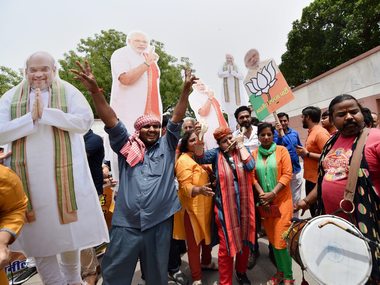The results of the Karantaka Assembly elections have now decisively established that the BJP is a mass-based party and not just an urban party, as may have been the case previously. The decisive lead of the BJP also seems to be a matter of surprise for the community of political analysts. The analysis of this election needs to take into consideration the factors which make the BJP a mass-based party. Such an analysis needs to go beyond the usual caste-based statistical analysis that we often lend our ears to. The campaign for the Karnataka elections and the period just preceding it gives us valuable insight on the reasons why the BJP is doing well with the masses. Objectively analysing the campaign of the Congress, we can broadly demarcate the issues on which the party was fighting the elections. Congress employed the age-old and time-tested electioneering techniques of fighting an election on the basis of considerations of caste and region. Months before the elections, we saw that the Siddaramaiah-led Congress government declared Lingayats as a religion separate from Hinduism. Any prudent person will know that this move was just to gain an electoral advantage and nothing else. [caption id=“attachment_4470185” align=“alignleft” width=“380”]  BJP workers in Delhi celebrate the results of the Karnataka election. PTI[/caption] A similar example can be recalled, when the Congress-led Union government agreed to divide Andhra Pradesh and carve out Telangana as a separate state, just before the 2014 Lok Sabha polls. In Karnataka, the Congress government created a separate flag for the state. The government also created a controversy by pitting Kannada against Hindi. All this was just before the state Assembly elections. An average voter in India is smart enough to recognise that these moves are just canvassing techniques. However, these techniques are still destructive and not constructive for the society. In the democratic form of polity, it is assumed at the policy level, that the political class will act with responsibility and that they will not exploit this loophole of the democratic process. These therefore, amount to misuse of the democratic process. The Congress party should realise that winning an election is important, but it is not more important than the fate of our country itself. An electoral victory should never be at the cost of the integrity of our country. The BJP’s narrative on the other hand is diametrically opposite. A random campaign rally of the BJP, anywhere in India, will almost be always accompanied by huge cheering of slogans like ‘Vande Mataram’ and ‘Bharat Mata Ki Jai’. This makes the election pitch of the BJP integrative and not destructive, wherein the country is prioritised over everything else. I assume that average Indians also are patriotic enough to put the cause of the nation before their personal interests, or the interests of their community, caste, religion or region. It is this fact which makes the continuous and exponential growth of the BJP possible and which leads to the decline of the Congress party. It is important to mention that the Congress has not always used such methods in their campaigning. These are recent additions and the party has been in decline since then. The Karnataka results are also indicative of the leadership crisis in the Congress. There is hardly any elaboration required on the situation of the central party leadership of the party. Rahul Gandhi has clearly come a cropper again. At the state level, at the time of filing this piece, chief minister Siddaramiah was himself trailing by more than 24,000 votes from Chamundeshwari, one of the two constituencies he has contested from. Narratives aside, the BJP trumped the Congress in sheer hard work too. Union ministers like Prakash Javdekar and Piyush Goyal spent months in the campaign. Prime Minister Narendra Modi himself led from the front and decisively changed the electoral atmosphere, post his rallies, in his party’s favour. Rahul Gandhi, Siddaramiah and other senior leaders of the Congress just didn’t put in a similar amount of effort. Siddaramiah was too engaged in Chamundeshwari, the seat he is set to lose. It is pertinent to mention that Karnataka has traditionally been a fertile ground for the Congress. The state has been its biggest bastion in the southern part of India. It may be recalled that Indira Gandhi herself had contested from Chikmagalur to make a comeback after getting defeated from Rae Bareli by Raj Narain in 1977. In 1999, Sonia Gandhi won from Bellary against Sushma Swaraj. In this election, the party is not doing well even in the Assembly segments of these two Lok Sabha constituencies. Clearly, everything which could go wrong for the Congress has gone wrong. Only serious reasons can justify such a massive decline of a party once termed as the grand old party of India. It is high time the Congress introspects the reasons for its decline. It is in the interest of the nation that there is a formidable opposition. The author is a Senior Fellow with the Department of Humanities and Social Sciences, IIT Bombay, Mumbai. He can be reached at raghav10089@gmail.com, Twitter: @raghavwrong Follow live updates on the Karnataka Assembly election results here.
The campaign for the Karnataka elections and the period just preceding it gives us valuable insight on the reasons why BJP is doing well with the masses.
Advertisement
End of Article


)
)
)
)
)
)
)
)
)



